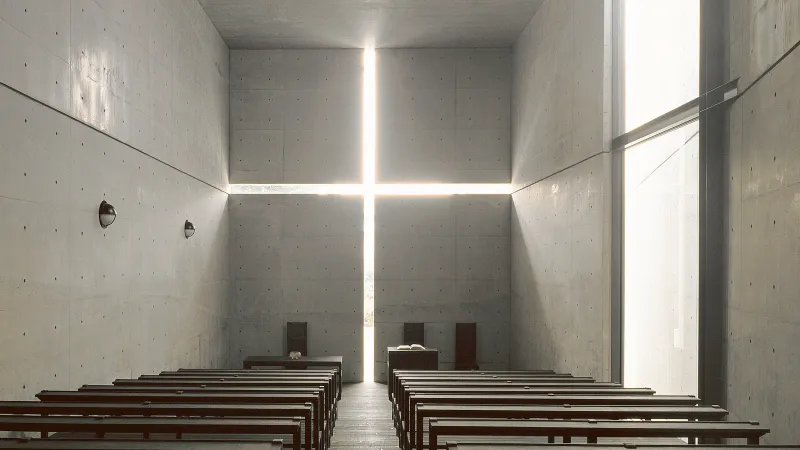The Church of Light, a masterpiece designed by Japanese architect Tadao Ando, seamlessly blends brutalist architecture with spiritual symbolism.
Located in Ibaraki, Osaka Prefecture, this iconic structure, constructed in 1989, is renowned for its powerful use of light and concrete.
Its unique design reflects Ando’s philosophical approach, creating a serene yet dramatic environment for reflection and worship.
1. Architectural Icon

Crafted by the visionary Tadao Ando, the Church of Light stands as a testament to brutalist architecture.
Its innovative use of simple geometric forms invites contemplation. Visitors are drawn to the interplay of light and shadow.
This iconic structure leaves a lasting impression, emphasizing the beauty in simplicity.
2. Geometric Design

The Church of Light is a masterpiece of geometric design. Its three concrete cubes intersect to form a unique space.
The angled wall adds dynamic tension. This clever design illustrates Ando’s genius, creating an engaging spiritual environment.
The simplicity and precision of the geometric forms captivate visitors.
3. Light as a Symbol

Light is central to the Church of Light’s ethos. A cross-shaped opening allows light to pour through, creating a mesmerizing effect.
This light symbolizes spiritual enlightenment. Ando’s design encourages introspection, bridging the gap between the spiritual and secular worlds.
The result is a profound, transformative experience.
4. Emptiness of Space

Entering the Church of Light, one is enveloped by emptiness. This intentional void creates a peaceful, contemplative atmosphere.
Ando’s design philosophy embraces emptiness, inviting the spiritual to fill the space.
This minimalist approach encourages visitors to reflect and find serenity amidst the stark surroundings.
5. Concrete Mastery

The Church of Light celebrates the artistry of concrete. Ando’s walls are smooth, reflecting light with a glass-like quality.
This precision elevates the material, transforming heavy concrete into something ethereal. The craftsmanship involved highlights the beauty in what might seem ordinary.
Visitors are left awestruck by this mastery.
6. Construction Challenges

The creation of the Church of Light faced financial hurdles. Initially, the budget constraints threatened the project’s completion.
Ando even considered building without a roof. However, the construction company donated the roof, ensuring the church’s realization.
This journey from challenge to triumph adds depth to its story.
7. Ando’s Philosophical Approach

Tadao Ando’s design philosophy permeates the Church of Light. He employs Zen principles, focusing on duality and existence.
His architectural choices encourage reflection on the spiritual and secular. The structure becomes a space for personal introspection.
Ando’s work goes beyond aesthetics, offering a deeper connection.
8. Symbolic Cross
A striking feature of the Church of Light is the cross cut into the concrete wall. This symbol is more than decorative. It’s a conduit for light.
Its alignment with the concrete joints speaks to meticulous design. The cross represents a spiritual invitation, welcoming light to illuminate the soul.
9. Unique Location

Nestled in Ibaraki, the Church of Light is a quiet sanctuary amidst urban life. Its proximity to Osaka allows for an accessible spiritual retreat.
The location enhances the church’s allure, offering a peaceful juxtaposition to the bustling city. This setting provides a perfect backdrop for reflection and worship.
10. Sustainable Design

Sustainability finds expression in the Church of Light. Ando’s use of repurposed scaffolding for benches and floors reflects environmental mindfulness.
This thoughtful approach aligns with contemporary values while adding character to the space.
These sustainable choices emphasize the importance of harmony with nature.


